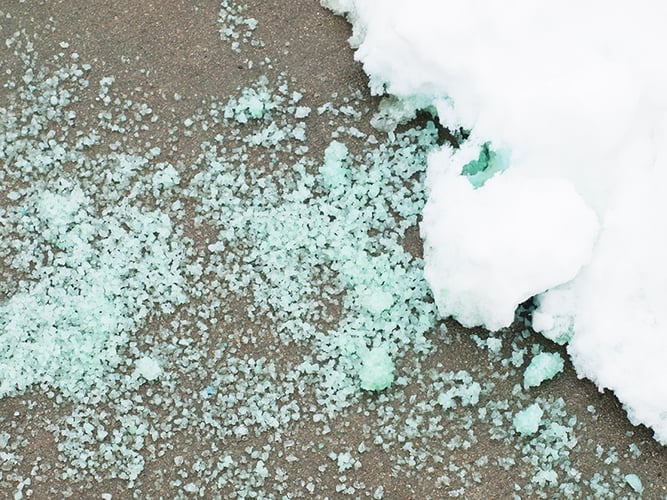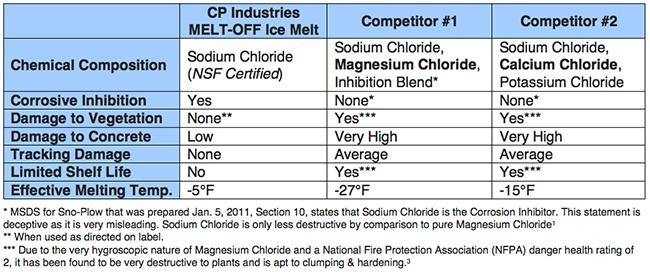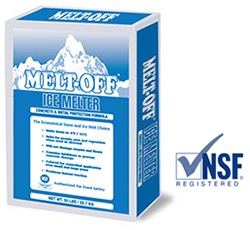
Millions of dollars of damage are caused each winter due to poor ice melt formulas and misleading information being passed to buyers pertaining to these formulas. Two particularly destructive and misleading elements commonly found in leading ice melters are Magnesium Chloride and Calcium Chloride. Be sure to educate yourself on how to safely use ice melt, and understand the different elements that make ice melters effective and safe. Read below to learn common terms and elements of ice melters and review side-by-side comparisons of specific formulas.
Ice Melt 101: Types of Ice Melt To Know
Rock Salt – rock salt is Calcium Chloride that is mined out of the ground and comes mixed with dark-colored, rough ground particles. Its size is very inconsistent, but pricing is low. Rock salt is only effective to 15 degrees - any colder than that, it no longer is effective at melting.
Solar Salt – solarized sodium based products are essentially salt water that is left to evaporate so that only a pure sodium product remains. If the sodium that is left is too small, it becomes table salt. If the sodium left is too large, it becomes dangerous to walk on.
Hygroscopic – is the ability of a substance to attract and hold water molecules from its surrounding environment. Ice melters that are composed of Magnesium Chloride and Calcium Chloride are hygroscopic.
Hygroscopic Magnesium Chloride and Calcium Chloride ice melters absorb moisture from the air causing three major problems:
-
Problem #1 - clumps in the bag becoming difficult to apply with a spreader resulting in loss of product and additional costs and labor.
-
Problem #2 - pulls moisture from hands, skin, plants, and other vegetation becoming harmful to both humans and the environment.
- Problem #3 - studies performed on various elements and their effects on concrete have found Calcium to be “extremely destructive” 1,2. Calcium Chloride and Magnesium (same family as Calcium) work against the Calcium in concrete sidewalks and parking structures through a process called lon-exchange1 where Calcium from ice melt exchanges places with Calcium in concrete. This exchange is irreversible and severely weakens and destroys structural integrity and longevity 4. Because of its inexpensive cost, many manufacturers add Calcium and Magnesium Chloride to their formulas as a way to mislead customers on quality and lower freezing points.
Safest Ice Melt for Concrete and Vegetation?
Studies have found that ice melt formulas that combine solar salt and anti-corrosion agents are less damaging to concrete and vegetation when compared to Magnesium Chloride and Calcium Chloride based ice melters. Due to the significant amount of scientific information on the concrete damaging effects of Magnesium Chloride and Calcium Chloride, we recommend MELT-OFF Ice Melter, a proprietary combination of solar salt, anti-corrosion agents, and over seven biodegradable and proven environmentally-friendly chemicals.
MELT-OFF does not contain Magnesium Chloride or Calcium Chloride, and is therefore not hygroscopic, and passed rigorous requirements by the U.S. patent office to not only drop temperatures lower than other competitors, but also greatly reduce or prevent damage to both concrete and steel. Its formula has also been verified by third-party testers and University researchers.5
Regional Distributors, Inc. is proud to be the only distributor in our market to offer MELT-OFF Ice Melter to ensure our customers are receiving the safest solution for your facility and community.
Comparison Charts of MELT-OFF Compared to Leading Competitor Formulas
Comparison tests reveal that MELT-OFF is significantly less damaging to concrete, metal, and vegetation when compared to other leading ice melters in the market. In addition, MELT-OFF has a longer shelf life compared to other leading ice melters and does not clump or harden, both qualities that provide you with a more cost-effective product.



Additional Benefits of MELT-OFF Ice Melter
- MELT-OFF is specifically filtered to be a safe, consistent size that is able to go through a spreader and remain effective in the melting process.
- Non-hygroscopic formula does not clump or harden.
- Affordable ice melter that offers concrete, metal, and vegetation protection, and is safe on carpets and flooring.
- Proprietary combination of solar salt and anti-corrosion agents effective to -5°F (-21°C).
- Certified by the National Sanitation Foundation (NSF).
- Safe, non-toxic to people, pets, and vegetation.
- Blue color for controlled application.
Make sure you have what you need before you need it this winter to
keep your guests, grounds, and facility safe.
1. Wang, K.D.E. Nelsen., W.A. Nixon,. Damaging Effects of Deicing Chemicals on Concrete Materials. Cement & Concrete composites 28, 2006.
pp.173-188.
2. Hyomin, L., R.D. Cody, A.M. Cody, and P.G. Spry,. Effects of Various Deicing Chemicals on Pavement Concrete Deterioration. Mid-continent
transportation symposium proceedings, 151.
3. Eaton, F.M. Toxicity and Accumulation of Chloride and Sulfate Salts in Plants. Journal of Agricultural Research, 1942.
4. Bonen, D. Composition and Appearance of Magnesium Silicate Hydrate and Its Relation to Deterioration of Cement-Based Materials. Journal
of the American Ceramic Society, Vol. 75, No. 10, 1992, pp. 2904-2906.
5. Documentation made available upon request to CP Industries.






